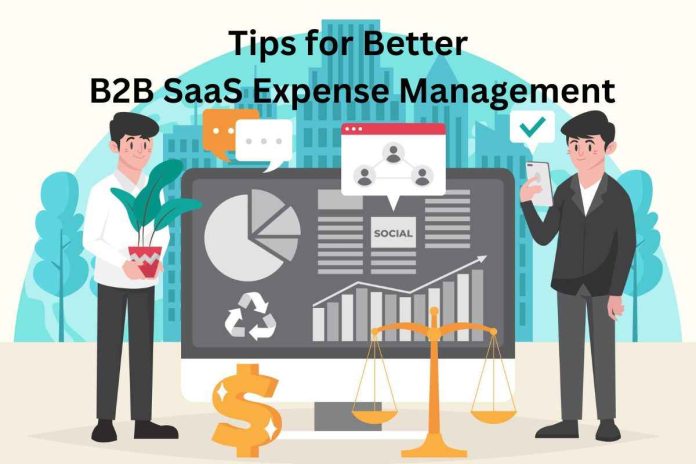The rapid increase in B2B SaaS spending reflects the expansion of the SaaS market and the rise in SaaS adoption.
The growth is accelerated by the way B2B SaaS has transformed how business operations are executed.
As businesses continue to switch to remote working, the demand for SaaS solutions that support communication, collaboration, and other business operations in a remote environment.
But this means organizations are spending more on SaaS products.
According to data by Vendr, companies with employees below one hundred spent $487,301 million in 2022:
But here is what you need to know:
Almost 29% of SaaS software spend is underutilized or goes to waste.
So how do you stop paying for SaaS products you’re not using?
In this article, you’ll discover practical tips for better B2B SaaS expense management.
Let’s get started.
Table of Contents
1. Establish the Reasons For Each SaaS Subscription
The first thing to do to better manage B2B SaaS expenses is to understand why you need each subscription.
As of 2021, organizations were using 110SaaS applications on average:
This number has increased significantly as many organizations turn to remote working.
But do you need all the subscriptions you have currently? Or are all the SaaS subscriptions you have delivering clear value?
Granted, your subscription should help your team automate manual and mundane tasks and save time.
Additionally, your subscription should help your team serve your customers better.
At no point should you pay for SaaS solutions with similar features or underutilized.
To avoid paying for SaaS solutions you aren’t using, consider auditing your subscriptions and talk to your teams to see whether all the current subscriptions are bringing true value.
2. Monitor SaaS License Usage
There is absolutely no point in paying for licenses for a SaaS solution that you’re not using.
For instance, why would you pay for 90 licenses for your CRM provider when your company has 70 employees? This means you’re wasting money on 20 licenses that are not getting used.
Sometimes the mistake of paying for underutilized licenses is caused by fluctuation in the number of employees. However, you can avoid this mistake by monitoring your license usage regularly.
Arguably, the two common reasons why SaaS licenses go unused are turnover and growth assumption.
For instance, team members who join the organization are added to SaaS platforms but when they depart, they are not removed from those platforms.
Another reason is that organizations that assume they will grow rapidly purchase more licenses but when they fail to grow, those licenses become a waste of money.
Your company should only pay for essential SaaS applications and licenses based on the current number of users.
3. Make a SaaS Budget and Audit Your Spending
This is also a good approach to better manage B2B SaaS expenses.
Managing SaaS spending can be challenging when your company grows and the number of employees increases.
A good idea is to leverage a platform that automates SaaS budgeting and accounting for subscriptions.
But you know what?
You need to understand how subscription billing works and how to choose the right subscription billing software. A B2B subscription billing software like Younium can help you to automate your billing process.
Also, you should create a quarterly or annual budget specifically for SaaS spending and monitor payments constantly.
4. Negotiate Pricing With Your Providers
As your company grows and the number of users increases, it’s a good idea to communicate with your SaaS application provider to get better pricing.
B2B SaaS providers are willing to readjust pricing as you expand usage. This is especially true for long-term subscriptions.
After all, providers aren’t willing to lose existing clients.
But remember that there is no point in expanding usage for the sake of negotiating pricing if you aren’t going to use some applications.
Only expand when you outgrow the subscription you’re already using.
Also, leverage reliable subscription management software to manage all your subscriptions efficiently.
Not sure how to choose suitable software for your B2B SaaS subscription management?
5. Check for Hidden Costs
Trying software and ultimately buying is easy but as you begin to expand usage, things can get complicated fast.
While the initial pricing might be low, ongoing fees, higher tiers, and feature-specific pricing can drive up costs faster than your initial budget can accommodate.
A good idea is to negotiate pricing with vendors about potential usage beforehand to ensure you understand any hidden costs associated with your subscription.
When purchasing your subscriptions, scrutinize the fine print carefully and ask questions where you don’t understand.
Further, pay attention to automatic renewals. Audit all automatic renewals and remember to discontinue those that you no longer need.
6. Test Before You Commit
Most B2B SaaS platforms and solutions offer a free trial that enables you to try before you decide to commit to fully purchasing.
It’s a good idea to take full advantage of trial plans to ensure your subscriptions offer all the essential features as you expand usage.
In fact, free trials are a great opportunity for your employees to familiarize themselves with a solution and check usability before you upgrade.
Conclusion
Better B2B SaaS expense management can benefit your company big time. It helps companies minimize operating costs by keeping track of their software spending across different departments.














